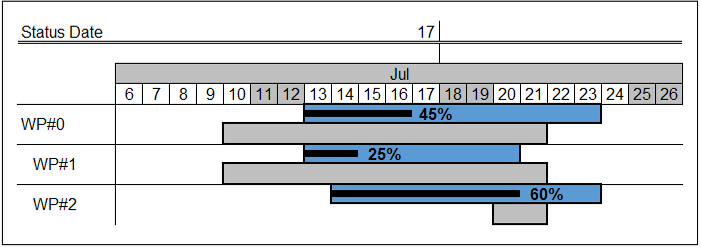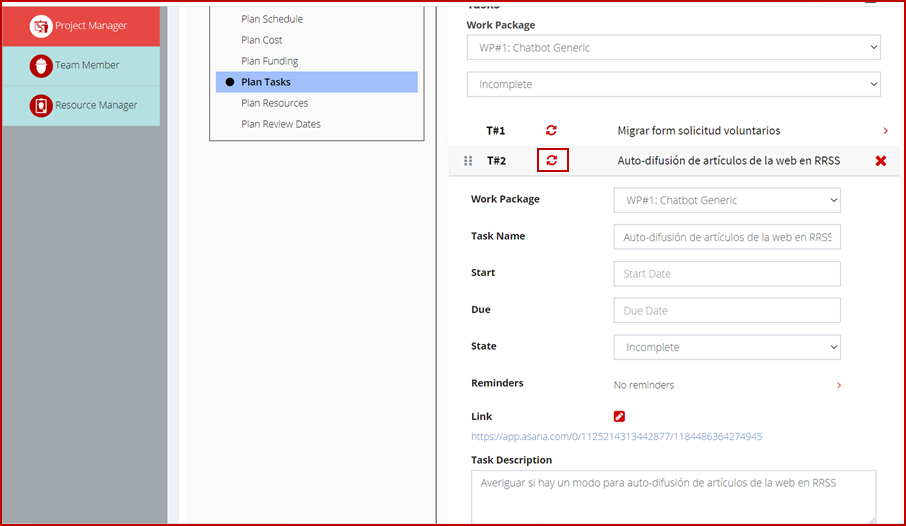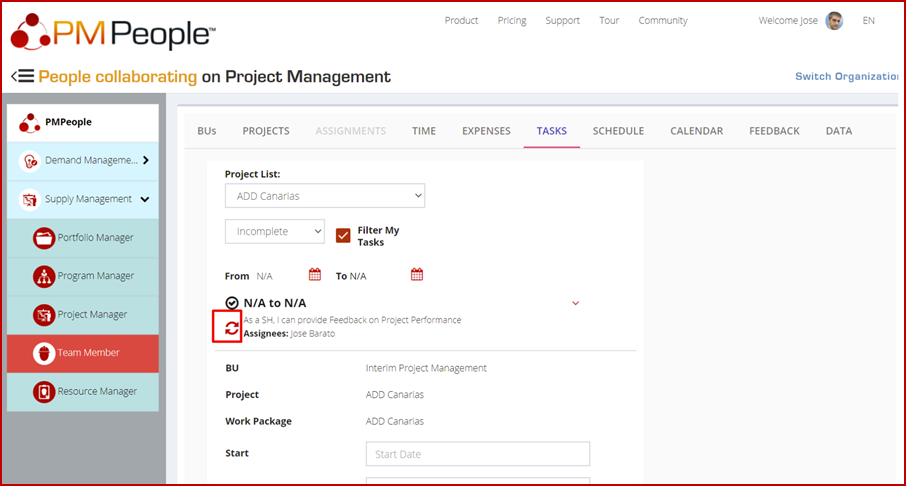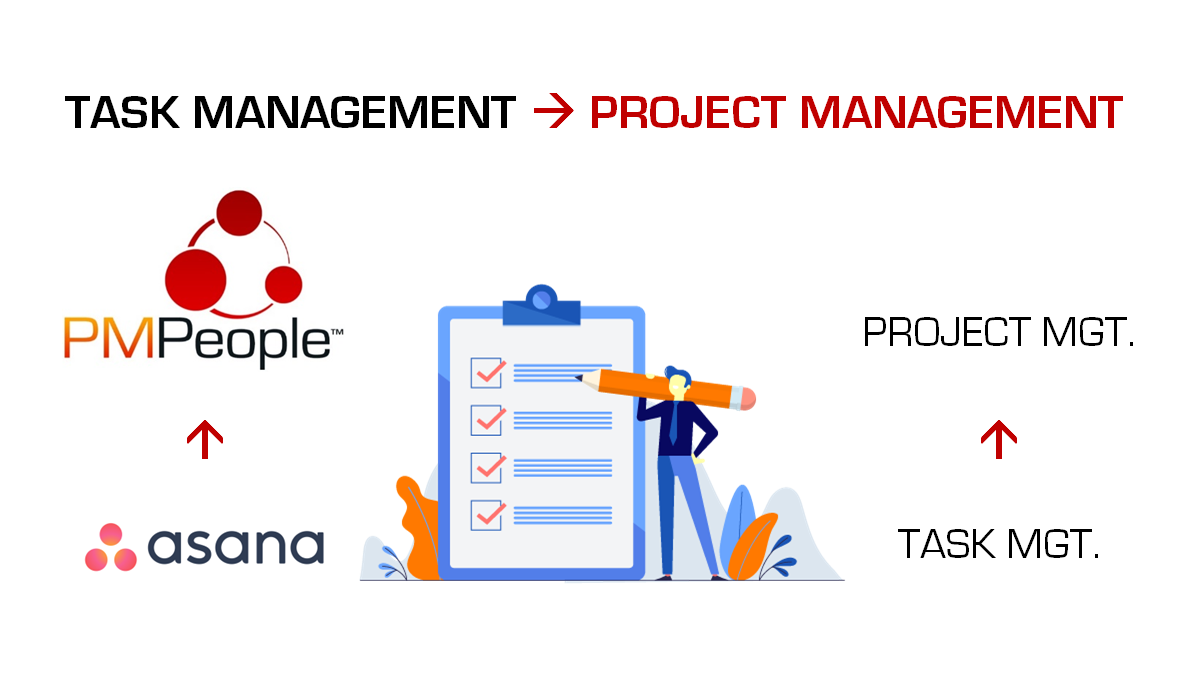Professional Project Management good practice consists of separating project management in two levels: Managers can control projects by managing project work packages. Team Members can control the project by managing project tasks. With PMPeople, you can manage work packages and tasks directly, but also it can be integrated with task management specialized tools, such as Asana.
Project managers should follow certain processes to get the project or phase finished on time, on budget, within the funding limits, avoiding out of scope work, meeting requirements, delivering high quality products, abiding and enforcing contracting terms with third parties, etc. They report regularly to steering committees, change control boards, PMO, etc. In status review meetings, they don’t report performance and problems only. They try to engage these governance entities to seek the solutions with them. The project manager is not the project owner. The performing organization owns the project. Projects should not be reported on the project level, as a whole, but on each work package. A project work package is the work defined at the lowest level of the work breakdown structure for which cost and duration are estimated and managed.
Project managers lead project teams. Project teams are in charge of technical tasks. Ideally, after team building, the team become into a synergic group, with its own identity, focused on technical excellence and continuous improvement. Good project managers aim two outcomes: the project product and the self-managed team, being the last one an organization asset of the highest value. At the individual level, team members grow professionally at high speed during the short term of a project, both their hard and soft skills. In the project economy, professionals do not belong to isolated business units anymore. Instead, they develop themselves progressively inside the organization, project after project.
Rita Mulcahy advised on planning the project with small pieces, so that each team member can accomplish several of them a single day. Tasks can be controlled with a yes or no. “Are you done yet?” is better than asking “What percent completed you?” on each project work package.
Managers should control scope, schedule, cost, etc., at the level of the project work packages. It is mostly a waste for them if they manage at the task level. Micromanagement is no good practice. Team members should know what work packages to report timesheets and expenses, but they also need a deeper detail to collaborate effectively as a team.
PPM tools should connect these 2 management layers, since they are interdependent:
- Team Members collaborate on tasks. Tasks can have many attributes, such as description, status (to do, in progress, done), assignees, collaborators, dates, percent complete, impediments, dependencies, etc. Usually, tasks are grouped on lists that can be ordered by priority –the higher the most important– or by other criteria. They can also be grouped on visual boards showing phases, calendars showing due dates, timelines showing dates and durations, etc. Tasks data should be aggregated on the corresponding project work packages, so that the management team can make decisions.
- On the project management level, the project management team can make many decisions, such as changes in priorities, scope, dates, cost and resource adjustments, risk responses, etc. These decisions, that can be managed at the work package level, need to be effectively translated to tasks.
PMPeople allows projects to be broken down into work packages, and work packages can be decomposed into tasks. Team members should know which work packages they are assigned to, mainly to report timesheets and expenses, but they also need to know their tasks and the information related.

Task data can be aggregated up to their work package to calculate dates, percent complete, etc.:
- If a work package includes 10 tasks and 3 of them have been completed, we can say percent complete is 30%.
- If a work package includes tasks with start and finish dates, work package’s percent complete can be calculated as a weighted average of percent completes and durations.
- Work package planned finish should be the due date of latest task.
- Work package planned start should be the start date of earliest task.
Let’s set an example to see how some automation rules can work. Imagine a project with two work packages (WP#1 y WP#2). WP#1 is baselined to start July 10th and finish July 21st. WP#2 is baselined to start by 10th, and finish by 21st. Therefore, the project itself –work package #0– is planned to start on July 10th and finish on 21st, taking a total duration of 8 days, just like WP#1.

Let’s move on to the project status date as of July the 17th.
Assume work package WP#1 has 6 tasks represented in this schedule chart:

Applying the aggregation rules, work package WP#1 data can be calculated automatically:
- Actual Start: July 13th (baseline start was 10th)
- Planned Finish: July 20th (baseline finish was 21st)
- Planned Duration: 6 days (baseline duration was 8 days)
- Percent Complete: 25% = (2+1)/(2+1+1+3+1+4)
Assume work package WP#2 has 2 tasks:

Applying the aggregation rules, work package WP#2 data can be calculated automatically:
- Actual Start: July 14th (baseline start was 20th)
- Planned Finish: July 23rd (baseline finish was 21st)
- Planned Duration: 8 days (baseline duration was 2 days)
- Percent Complete: 60% = 6/(6+4)
Finally, project (WP#0) schedule status can be calculated as of July 17th:

- Actual Start: July 13rd (baseline start was 10th)
- Planned Finish: July 23rd (baseline finish was 21st)
- Planned Duration: 9 days (baseline duration was 8 days)
- Percent Complete: 45% = (25%*6+60%*8)/(6+8)
PMPeople can manage work packages and tasks directly from its very beginning. Now we are launching Asana integration, so that people can upload task data from Asana.
Asana freemium tool is growing exponentially to make knowledge workers coordination easy. With prospects for an IPO this year, Asana has recently launched some premium features to navigate and focus priority work by means of AI, also for meetings productivity, workflow automation, OKRs, etc. These are great innovations defining the future of collaborative work.
For all these reasons, we have chosen Asana to start integrating task management tools. Following the same integration design, we plan to integrate other tools like Jira, Trello, Wrike, Basecamp, Monday, Samepage, etc.
Project managers can connect a work package to an Asana project in section INITIATION > Project Data > Connect, by clicking the Asana icon:

First time, PMPeople user has to give permission to integrate both tools clicking the button [Authorize Asana]:

User is noticed about the terms of the integration:

Inside Asana, user can check if PMPeople is properly authorized in section My Profile Settings… > Apps:

A new work package connection can be added by clicking the [+] icon:

Then, user can match the PMPeople work package to the Asana project:

Once the connection is made, a new row is shown with the Asana project public link:

Current integration moves data only in one direction: from Asana to PMPeople.
Any manager can upload Asana data just clicking the sync icon for each work package:

Managers can also sync all connected packages at once in section PLAN > Plan Tasks, clicking the button [Import Tasks]:

If there are new tasks in Asana, they will be added to the task list in PMPeople:

Each task can be synced, individually:

Managers can also sync each task in section CONTROL > Control Tasks:

Team Members can sync their tasks in section TASKS:

Jose Barato
Related posts
Categories
- Business (16)
- Demand Management Roles (14)
- Frequently Asked Questions (7)
- Guide (26)
- People (23)
- Assignments (2)
- Feedback (2)
- Project Team (3)
- Tracking Time And Expenses (2)
- Process (9)
- Closing (2)
- Executing And Controlling (2)
- Planning (1)
- Project Management (67)
- Management Frameworks (18)
- Organization Owner (OO) (3)
- Project Economy (54)
- Tools (19)
- Supply Management Roles (5)
- Training (6)
- Uncategorized (1)



